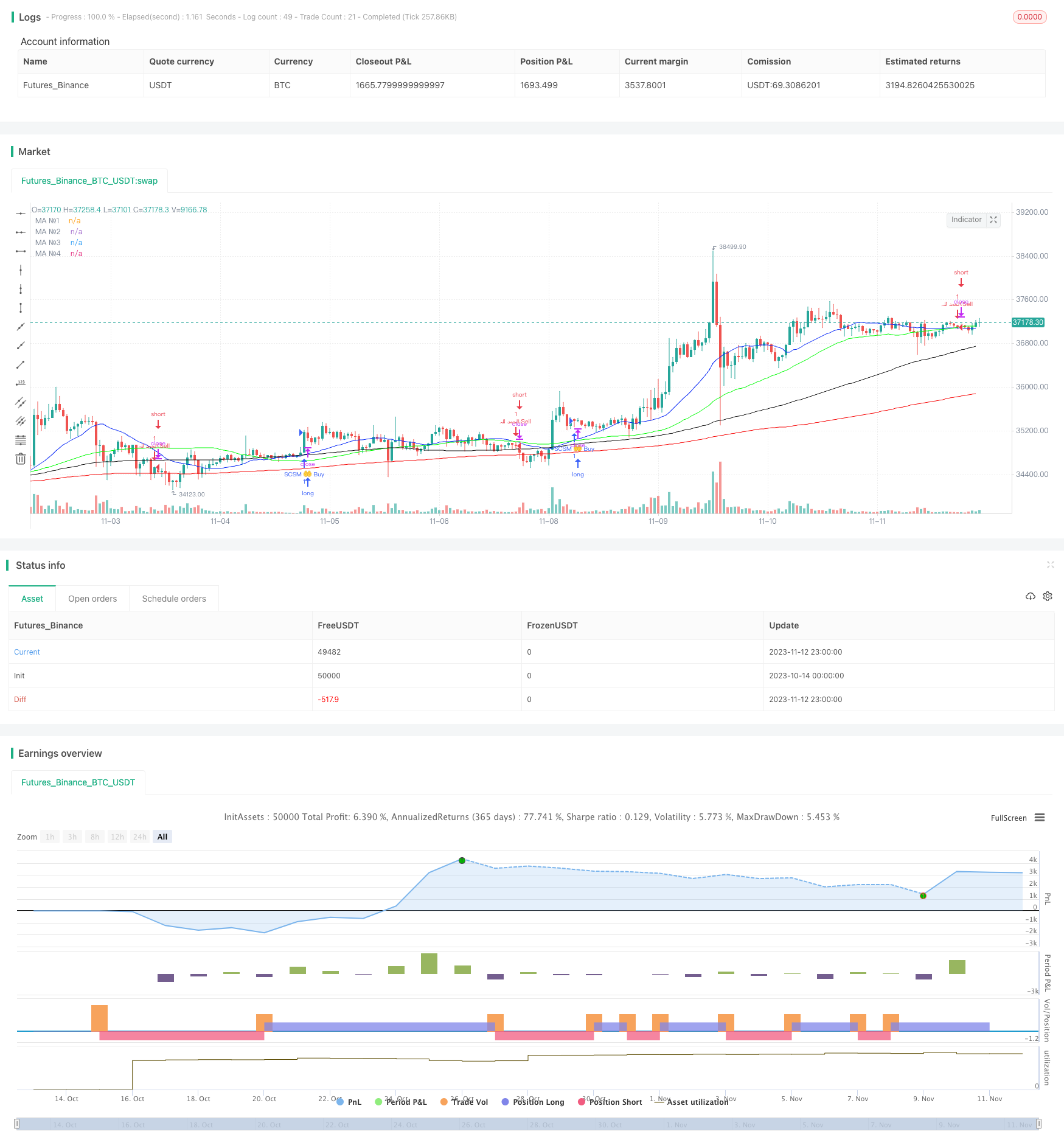
概述
该策略基于多条不同时间周期的简单移动平均线(SMA)的金叉死叉来判断行情趋势和发出买卖信号。策略采用20日线、50日线、100日线和200日线四条SMA。当短期SMA上穿长期SMA时为金叉信号,做多;当短期SMA下穿长期SMA时为死叉信号,做空。
策略原理
该策略的核心逻辑基于以下几点:
计算多条不同时间周期的SMA,包括20日线、50日线、100日线和200日线。
判断短期SMA(20日线)与长期SMA(50日线、100日线、200日线)的交叉情况。
当20日线上穿50日线时判断为金叉信号,做多;当20日线下穿50日线时判断为死叉信号,做空。
与此同时,50日线、100日线和200日线要满足大趋势判断逻辑,即较长周期的SMA要位于较短周期的SMA之上。
入场信号优先级:20日线与50日线>20日线与100日线>20日线与200日线。
出场信号为20日线重新跨过50日线。
该策略主要依靠SMA线的交叉来判断趋势方向。在牛市中,短期SMA上穿长期SMA为金叉信号,表示行情可能进入趋势;在熊市中,短期SMA下穿长期SMA为死叉信号,表示行情可能进入调整。另外,较长周期SMA要高于较短SMA也是确认大趋势的判断依据。
策略优势
该策略具有以下几点优势:
策略思路简单清晰,易于理解和实现。
使用SMA指数移动平均线,相比EMA更能有效过滤市场噪音,识别趋势。
多组时间周期SMA结合使用,可以提高信号的可靠性。
入场信号优先级设定合理,避免过早入场。
可自定义SMA周期和颜色,优化策略。
可在多种时间周期使用,适合不同交易风格。
SMA交叉系统对大盘趋势的判断非常准确有效。
策略风险
该策略也存在以下风险:
在震荡行情中,SMA交叉信号频繁,可能产生大量错误信号。
固定的SMA周期无法适应市场的变化,应该结合趋势和波动率优化SMA参数。
仅凭SMA交叉无法确定入场时机,应该结合其他指标如MACD辅助判断。
SMA本质具有滞后性,应提前优化入场时机或使用限价单。
该策略对交易资金管理要求高,必须严格遵守止损逻辑。
应充分考虑交易成本对策略盈利能力的影响。
策略优化
该策略可以从以下几个方面进行优化:
优化SMA周期参数,不同周期参数适用于不同市况,可以结合ATR动态优化。
增加其他指标结合,如MACD、RSI等来辅助过滤入场时机。
增加趋势判断逻辑,如ADX,避免震荡市错交易。
优化止损方式,可按ATR止损或跟踪止损。
优化仓位管理,根据资金规模动态调整每单仓位。
测试不同品种参数效果,根据特性调整SMA周期。
多时间框架结合,确保大周期趋势一致。
总结
整体来说,该SMA金叉死叉策略通过简单的移动平均线交叉系统判断趋势方向,可靠性较高,适合大多数交易者。但其本身存在一些滞后性和错误信号问题。我们应该从优化入场时机、止损方式、仓位管理等方面继续完善该策略,使其在不同市场环境中都能具备稳定的盈利能力。多种技术指标和趋势判断的综合运用,才能使趋势跟踪策略真正做到稳健、高效、可靠。
/*backtest
start: 2023-10-14 00:00:00
end: 2023-11-13 00:00:00
period: 1h
basePeriod: 15m
exchanges: [{"eid":"Futures_Binance","currency":"BTC_USDT"}]
*/
// This source code is subject to the terms of the Mozilla Public License 2.0 at https://mozilla.org/MPL/2.0/
// © xyzdesign1989
//@version=5
strategy("SMA crossover buy/sell [SCSM_Algo]", overlay=true, margin_long=3000, margin_short=3000)
BuyCond = ta.crossover(ta.sma(close, 20), ta.sma(close, 50)) and ta.sma(close, 20) > ta.sma(close, 50) and ta.sma(close, 50) > ta.sma(close, 100) and ta.sma(close, 100) > ta.sma(close, 200) or (ta.crossover(ta.sma(close, 20), ta.sma(close, 100)) and ta.sma(close, 20) > ta.sma(close, 50))
if (BuyCond)
strategy.entry("SCSM 🤲 Buy", strategy.long)
SellCond = ta.crossunder(ta.sma(close, 20), ta.sma(close, 50))
if (SellCond)
strategy.entry("الحمد للہ،Sell", strategy.short)
ma(source, length, type) =>
type == "SMA" ? ta.sma(source, length) :
type == "EMA" ? ta.ema(source, length) :
type == "SMMA (RMA)" ? ta.rma(source, length) :
type == "WMA" ? ta.wma(source, length) :
type == "VWMA" ? ta.vwma(source, length) :
na
show_ma1 = input(true , "MA №1", inline="MA #1")
ma1_type = input.string("SMA" , "" , inline="MA #1", options=["SMA", "EMA", "SMMA (RMA)", "WMA", "VWMA"])
ma1_source = input(close , "" , inline="MA #1")
ma1_length = input.int(20 , "" , inline="MA #1", minval=1)
ma1_color = input(#0929f6, "" , inline="MA #1")
ma1 = ma(ma1_source, ma1_length, ma1_type)
plot(show_ma1 ? ma1 : na, color = ma1_color, title="MA №1")
show_ma2 = input(true , "MA №2", inline="MA #2")
ma2_type = input.string("SMA" , "" , inline="MA #2", options=["SMA", "EMA", "SMMA (RMA)", "WMA", "VWMA"])
ma2_source = input(close , "" , inline="MA #2")
ma2_length = input.int(50 , "" , inline="MA #2", minval=1)
ma2_color = input(#00fb04, "" , inline="MA #2")
ma2 = ma(ma2_source, ma2_length, ma2_type)
plot(show_ma2 ? ma2 : na, color = ma2_color, title="MA №2")
show_ma3 = input(true , "MA №3", inline="MA #3")
ma3_type = input.string("SMA" , "" , inline="MA #3", options=["SMA", "EMA", "SMMA (RMA)", "WMA", "VWMA"])
ma3_source = input(close , "" , inline="MA #3")
ma3_length = input.int(100 , "" , inline="MA #3", minval=1)
ma3_color = input(#131313, "" , inline="MA #3")
ma3 = ma(ma3_source, ma3_length, ma3_type)
plot(show_ma3 ? ma3 : na, color = ma3_color, title="MA №3")
show_ma4 = input(true , "MA №4", inline="MA #4")
ma4_type = input.string("SMA" , "" , inline="MA #4", options=["SMA", "EMA", "SMMA (RMA)", "WMA", "VWMA"])
ma4_source = input(close , "" , inline="MA #4")
ma4_length = input.int(200 , "" , inline="MA #4", minval=1)
ma4_color = input(#f60c0c, "" , inline="MA #4")
ma4 = ma(ma4_source, ma4_length, ma4_type)
plot(show_ma4 ? ma4 : na, color = ma4_color, title="MA №4")